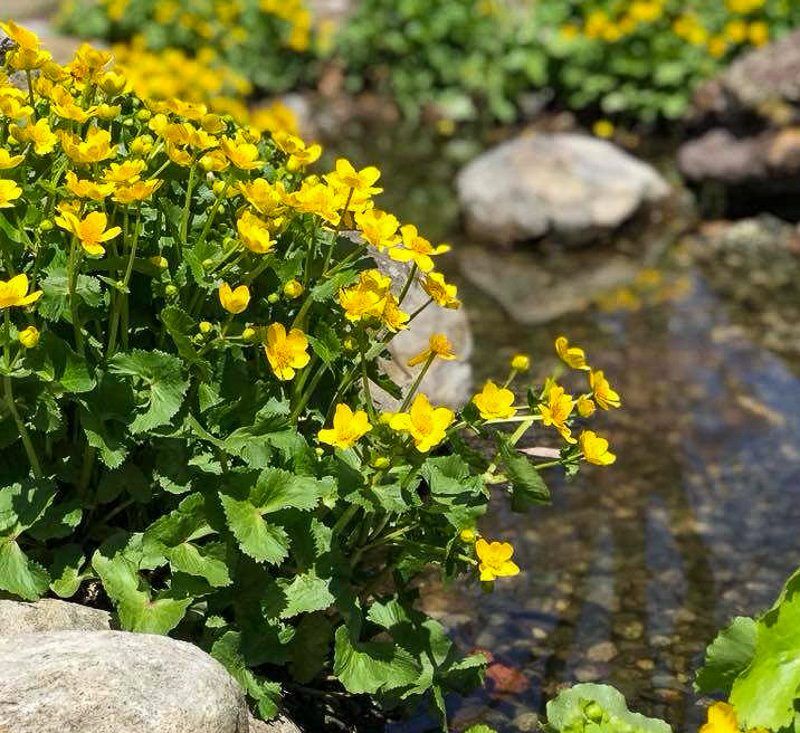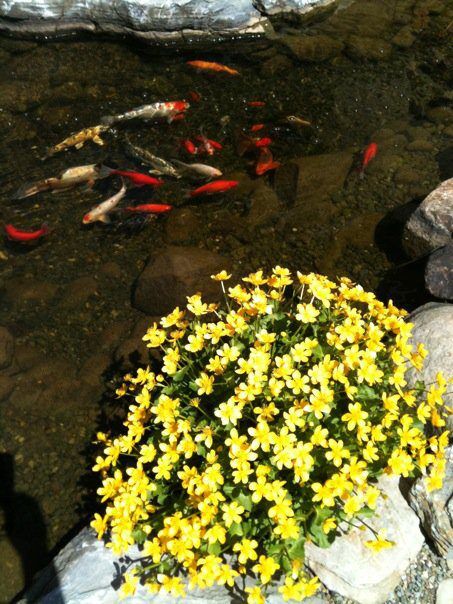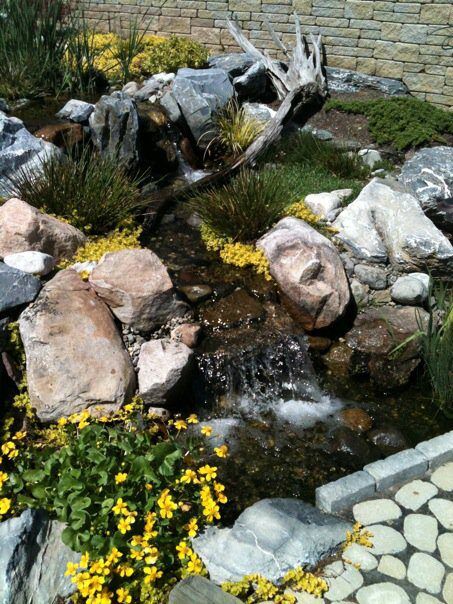ABOUT THIS PLANT
Marsh Marigold
Caltha palustris
Waxy and bright, they are the first to bloom in early spring. Sunny golden yellow flowers shine above mounds of round green foliage.
| Flower | Yellow |
|---|---|
| Bloom Time | Spring |
| Foliage | Green, Heart-Shaped |
| Hardiness Zone | 3 |
| Height | 6-12 Inches |
| Exposure | Part Sun to Shade |
| Where to Plant | Moist Soil to Shallow Water (Up to 2 Inches Deep) |
| Aggressive Grower? | No |
| Growth Rate | Slow |
| Pond Size | Any |
How to Care for Your Marsh Marigold
Marsh Marigold Basics
A pond plant that doesn’t make you wait until summer for flowers? And it doesn’t mind shade?
What more could you ask for?
Marsh Marigolds are a great addition to the streams, moist edges or shallow shelves of any pond. These pretty plants aren’t related to terrestrial marigolds but instead are members of the buttercup family – a fact evident in Marsh Marigold’s small-but-vibrant yellow flowers.
These blooms mark the start of spring throughout most of the U.S., blooming around the same time as forsythia. This early bloom time not only adds some color to a pond that’s still waking up for the season but also helps remove nitrates that might otherwise feed string algae in the spring.
Marsh Marigold’s flowers will usually disappear with the start of hot weather, but you’ll still have the nice neat mounds of green foliage to enjoy throughout the season.
Marsh Marigold is a well known and loved favorite in the water gardening toolkit. Its mild manners make it a perfect fit for any pond.
You might also hear Marsh Marigold called names like kingcup or cowflock or, if you travel to Great Britain, Mayblob or pollyblob.
Planting
Marsh Marigolds prefer moist soil or shallow water up to 2 inches deep. They’re a perfect fit for streams or bogs.
These plants perform best in part sun to shade.
You have three options when it comes to putting your Marsh Marigold in your pond: keeping it in the pot it comes in, replanting it in a fabric plant pot or planting it directly in the pond.
Planting Your Marsh Marigold
We recommend planting Marsh Marigolds directly into the pond or stream whenever possible. Doing so not only takes away the burden of an unsightly pot but also gives your plant the ability to pull nutrients out of the water. This natural filtration helps prevent string algae and keeps your fish happy and healthy.
To plant your Marsh Marigold, remove the plant from the pot. You can do this by carefully dumping out the contents or cutting the pot away with a soil knife. Then gently press the soil and roots against the pond liner and cover with enough rocks and gravel to keep it in place. That’s it!
Keeping the Store Pot
If you keep your plant in the pot in which you bought it, simply place the pot in at least 2 inches of water and surround with rocks to prevent it from tipping over. When choosing a spot, make sure your plant is safe from koi or other fish that might try to play football with an unsecured pot.
Some people like to add a thin layer of gravel to the top of the plant for decoration or to contain dirt if the top of the pot is submerged. For additional aesthetic appeal, cut away the top rim of the pot.
Moving to a Fabric Planter
Moving your plant to a fabric planter will give it a little more space to spread its roots.
If you choose to go this route, simply place the plant – soil and all – into the planter and fill in the remaining space with aquatic planting media.
Add gravel to the top if desired, then slowly lower the planter into the pond at an angle to keep as much of the soil in the pot as possible.
Dealing with Dirt
Regardless of how you choose to display your plant, you might see a little bit of soil make its way into your pond. This is normal and will clear up on its own if you have a skimmer.
If you like to keep your pond spotless and don’t want to wait for the dirt to settle, place a Fine Filter Pad (available at Splash) in your skimmer to catch the extra tiny particles of dirt. Simply place the pad anywhere in the skimmer where the water will pass through, then remove the pad as soon as the water is clear.
Add a flocculant like Rapid Clear for even faster results.
In-Season Care
Marginal plants are easy to care for year-round.
Most marginals don’t need additional fertilizer if they’re planted directly in a pond or stream. They get all the nutrients they need right from the water. If your plant is still in a pot, however, you’ll want to use a once-a-year aquatic plant fertilizer.
Remove dead leaves and flowers from your plant throughout the season. Regular maintenance will help it channel its energy into healthy growth.
Marsh Marigolds are slow growers and unlikely to take over a pond. If your plant does seem to outgrow its spot, simply pull it out of the pond or pot, and divide it as needed.
Winter Care
Marsh Marigolds are winter hardy to Zone 3, meaning they’ll survive most U.S. winters.
You don’t need to cut back your Marsh Marigold in winter. Simply remove dead foliage in the spring.
Plants to Pair with Marsh Marigold
The gallery was not found!Each type of plant you add to your pond pulls a different kind of nutrient out of the water. A yellow flower takes out different nutrients than a red one, and a wide leaf takes out different nutrients than a narrow one.
These nutrients will go on to feed string algae if left to grow unchecked, so the more and the wider variety of plants you have in your pond, the better.
Choose plants with a variety of colors, shapes, heights and bloom times. This mix will not only maximize nutrient uptake but also keep your pond looking beautiful throughout the season.
Plants that pair well with Marsh Marigold include Queen Victoria, Golden Creeping Jenny and Spike Rush.
More Pond Plant Tips
| Flower | Yellow |
|---|---|
| Bloom Time | Spring |
| Hardiness Zone | 3 |
| Height | 6-12 Inches |
| Exposure | Part Sun to Full Shade |
| Where to Plant | Moist Soil or Shallow Water (Up to 2 Inches Deep) |


